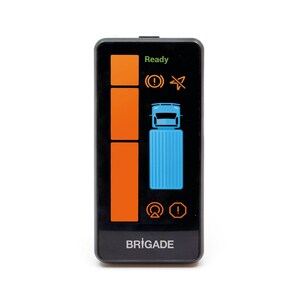Brigade Electronics: Delivering Safety in the Distribution Sector
PORTLAND, Indiana, July 8, 2019 /PRNewswire/ -- As the online retail business continues to enjoy rapid growth, there's an ever-increasing network of distribution vehicles flooding the roads. What does this mean for road safety and how can drivers ensure they are doing everything they can to protect themselves and other road users from harm?
Global online retail sales have risen sharply in the last five years with the total amount of spending increasing from 5.9% in 2014 to 8.8% in 2018, equating to USD$2.489 trillion in revenue for businesses.
In the US, the average online shopper will spend $1,804 per year purchasing goods online, with 24% shopping at least once per week.
With this growth in online sales comes a greater number of delivery vehicles on the roads and an increasing network of self-employed drivers – many of whom are responsible for ensuring that they and their vehicles are operating safely.
A study of self-employed drivers and couriers, carried out in the UK by the University of London, has shown that they are at a heightened risk of being involved in a traffic incident with one in ten reporting that someone had been injured as a result of a collision. The study also found that almost two thirds (63%) had not been provided with safety training, while 65% said they had no safety equipment.
According to the World Health Organization (WHO), more than half of all road traffic deaths are vulnerable road users: pedestrians, cyclists and motorcyclists. Blind spots on vehicles are a major contributing factor to collisions and are often the main reason vulnerable road users are killed or injured. For example, when cyclists aren't spotted by a larger vehicle with limited driver visibility while making a turn. Preventing deaths and keeping roads safe is clearly a challenging task.
Studies in the US have revealed that adding safety technology to trucks has the potential to prevent up to 63,000 commercial truck related crashes each year. These include eliminating blind spots on vehicles by installing safety monitoring systems such as 360-degree cameras.
Corey Heniser, is a vehicle safety expert at Brigade Electronics INC. He said:
"While large mirrors have traditionally been used to address the issue of blind spots, they cannot completely eliminate them. Research has shown that in the time it takes a driver to scan four mirrors, assess and then react to hazards, a vehicle could travel as far as 33 feet. However, if a vehicle camera safety system is installed this will eliminate blind spots by providing a complete surround view of the vehicle in real time in a single image. These are the types of safety products we'd like all distribution drivers to use so that we can make the roads safer."
Such systems include Brigade's Backeye®360, which combines images from ultra wide-angle cameras, resulting in a 'bird's-eye view' of the vehicle and surrounding area, which is displayed on a monitor in the driver's cab.
Simple reversing alarms have long been used to alert people walking near moving vehicles, but research has shown that old-fashioned tonal alarms may be adding to the problem as pedestrians cannot always locate the direction from which the alarm originates. Multi-frequency alarms are solving this problem. Rather than the traditional 'beep beep' of tonal alarms, they create a 'ssh-ssh' sound which is gentle on the ear and dissipates quickly, meaning the alarm can be instantly located and heard only in the danger zone. These systems are particularly useful for delivery vans that will often have to make slow or difficult maneuvers on narrow roads or travel through busy streets shared with cyclists, pedestrians and motorcyclists.
While technology is key to helping prevent injuries and deaths, it is also essential for commercial drivers to be fully committed to implementing robust safety strategies and plans so that demonstrable progress can be made. This includes investing in the relevant training so that they are aware of the potential hazards and are fully prepared to react.
Corey added:
"Fitting technology doesn't mean a driver's safety obligations have been met. They need to be mindful of other road safety strategies that will help prevent the likelihood of a collision. These include completing relevant training and taking regular breaks while on the road to avoid fatigue."
SOURCE Brigade Electronics

WANT YOUR COMPANY'S NEWS FEATURED ON PRNEWSWIRE.COM?
Newsrooms &
Influencers
Digital Media
Outlets
Journalists
Opted In





Share this article